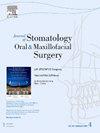Relations between bone density from computed tomography and bone regeneration after reduction mandibuloplasty
IF 1.8
3区 医学
Q2 DENTISTRY, ORAL SURGERY & MEDICINE
Journal of Stomatology Oral and Maxillofacial Surgery
Pub Date : 2024-09-12
DOI:10.1016/j.jormas.2024.102073
引用次数: 0
Abstract
Background
Bone regeneration in the mandibular angle region after reduction mandibuloplasty may compromise the aesthetics of the lower face and thus lead to revision surgery. Bone quality is known to play an important role in osteogenesis. However, no study has evaluated the relationship between mandibular bone quality and bone regeneration volume.
Methods
The bone density of the mandibular angle immediately after surgery (BD) was determined as the grey level in computed tomography (CT) images. Based on the immediate postoperative and long-term follow-up CT images, the volumes of the regenerated angle (VSA) and the regenerated outer cortex (VOC) were measured after model reconstruction, automatic alignment and Boolean operation. Correlation analyses were then performed between VSA and BD, VOC and BD.
Results
23 patients (46 mandibular angles) were included in this study. The average BD was 907.09 ± 111.89 HU. The mean VSA was 201.66 (131.73–357.24) mm3. Spearman correlation analysis revealed a positive correlation between BD and VSA (r = 0.5449, p < 0.0001). The mean VOC was 236.23 ± 151.35 mm3. Pearson correlation analysis found a negative correlation between BD and VOC (r = -0.3501, p = 0.0171).
Conclusions
CT images can provide a quantitative assessment of mandibular bone quality. BD may influence the volumes of bone regeneration in different areas of the mandibular angle portion after reduction mandibuloplasty, in the regenerated angle area positively and in the regenerated outer cortex region negatively. Therefore, slight over-grinding may be a choice to prevent secondary angulation.
计算机断层扫描得出的骨密度与下颌骨缩小整形术后的骨再生之间的关系
下颌角缩小整形术后下颌角区域的骨再生可能会影响下面部的美观,从而导致翻修手术。众所周知,骨质在骨生成中起着重要作用。然而,还没有研究评估过下颌骨骨质与骨再生量之间的关系。下颌角术后即刻的骨密度(BD)是根据计算机断层扫描(CT)图像的灰度水平确定的。根据术后即刻和长期随访的 CT 图像,经过模型重建、自动配准和布尔运算,测量了再生角(V)和再生外皮层(V)的体积。然后在 V 和 BD、V 和 BD 之间进行相关性分析。本研究共纳入 23 名患者(46 个下颌角)。平均 BD 为 907.09 ± 111.89 HU。平均 V 值为 201.66 (131.73-357.24) mm。斯皮尔曼相关分析显示,BD 和 V 之间呈正相关(= 0.5449,< 0.0001)。平均 V 值为 236.23 ± 151.35 毫米。皮尔逊相关分析发现,BD 和 V 之间呈负相关(=-0.3501,=0.0171)。CT 图像可对下颌骨质量进行定量评估。BD 可能会影响下颌骨缩窄整形术后下颌角部分不同区域的骨再生量,对再生角区域有积极影响,对再生外皮质区域有消极影响。因此,轻微的过度磨削可能是防止继发性成角的一种选择。
本文章由计算机程序翻译,如有差异,请以英文原文为准。
求助全文
约1分钟内获得全文
求助全文
来源期刊

Journal of Stomatology Oral and Maxillofacial Surgery
Surgery, Dentistry, Oral Surgery and Medicine, Otorhinolaryngology and Facial Plastic Surgery
CiteScore
2.30
自引率
9.10%
发文量
0
审稿时长
23 days
 求助内容:
求助内容: 应助结果提醒方式:
应助结果提醒方式:


